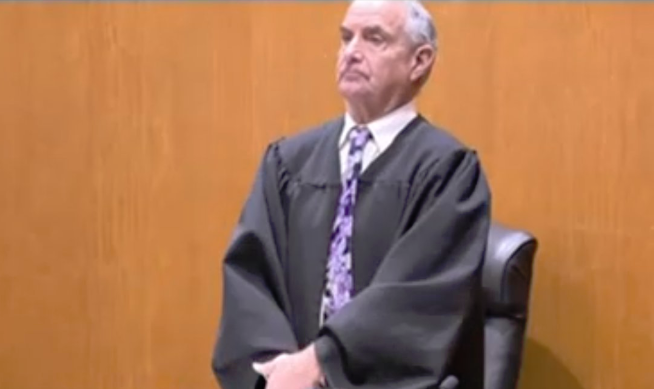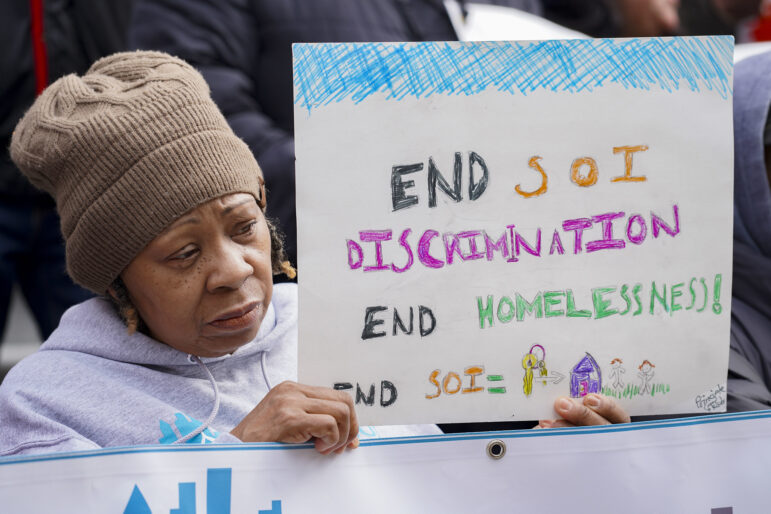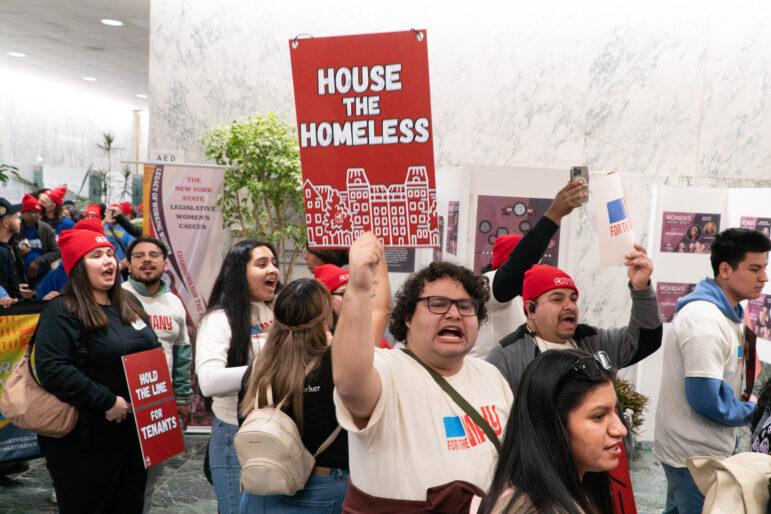
NY1/Twitter
Judge Michael Aloise
Throughout the recent high-profile trial of Chanel Lewis for the murder of Howard Beach jogger Karina Vetrano, Judge Michael Aloise sparked controversy.
In addition to repeatedly ruling in the prosecution’s favor, Aloise frequently sported a purple tie, a statement of solidarity with the Vetrano family. Many seasoned criminal defense attorneys were surprised when after only one full day of jury deliberations, Aloise—instead of issuing what’s known as an Allen charge (which asks jurors to continue trying to reach a verdict)—quickly declared a mistrial.
Queens prosecutors immediately declared their intention to seek a retrial, and the next court date is January 22. Despite his questionable handling of the first trial, Justice Aloise continues to preside over the case.
A City Limits investigation has found that questions raised about Aloise’s impartiality are not new. Indeed, since Aloise became a Queens Supreme Court-Criminal judge in 2004, Aloise has had at least 42 cases reversed or modified by the appellate division, with a handful reaching the full New York State Court of Appeals.
By contrast, Aloise’s Queens counterpart Justice Gregory Lasak, who was elected at the same time as Aloise, has had 17 reversals or modifications, including one last week. Lasak made important initial rulings in the Vetrano case before retiring last summer in order to run for Queens DA. His cases were then passed over to Aloise. Kenneth Holder, another Queens judge who handles high-profile felony trials, has seen 24 of his cases altered by the appellate division since he joined Aloise and Lasak in 2008.
As the Queens DA’s office prepares to retry Lewis, Aloise’s track record could come in for scrutiny—and raise questions about whether there is sufficient oversight and accountability of judges in New York State.
Nearly two dozen new trials ordered
Along with Brooklyn and Westchester, Queens is covered by the 2nd Division-Appellate Department of the New York Supreme Court. That division affirms the overwhelming majority of felony convictions, and in recent years the 2nd Division’s case reversal rate stood at a mere 3-5 percent.
Whereas many affirmed convictions can acknowledge “harmless errors” by a judge, “reversible errors” provide grounds for a new trial or re-sentencing. Nearly two dozen times over the last 15 years, the 2nd Department has ordered new trials in Aloise’s cases.
The appellate division has cited a variety of problems with Aloise’s actions at nearly every stage of a trial, from his rulings on the initial legality of the arrest and what constitutes admissible evidence through voir dire (jury selection), jury instructions and sentencing.
Aloise’s overturned cases show him to have repeatedly made erroneous rulings in favor of the prosecution. In the People v. Patterson (2009), a panel of four appellate judges unanimously ruled that the phrasing of Aloise’s Allen charge to the jury—”[W]e are going to keep you together until we have a verdict”—coerced a guilty-on-all-charges conviction. In People v. Chestnut (2012), the full Court of Appeals ruled that Aloise had improperly allowed the prosecution to convict Kevin Chestnut, a robbery defendant, by allowing the case to be combined with Chestnut’s co-defendant’s unrelated drug case.
“Judge Aloise has never met a criminal defendant he didn’t want to put away—unless that person had a badge,” says veteran criminal defense attorney Ron Kuby, who represented a defendant in a notable Aloise case that reached the Court of Appeals.
Aloise indeed made headlines last year when he rejected Queens prosecutors’ request for a six-month jail sentence for Kevin Desormeau, a former NYPD officer convicted of lying under oath about his role in planting evidence in a drug arrest. Despite the perjury verdict, Aloise declared that sentencing Desormeau to jail would feed the “false narrative that police officers are not to be trusted and their testimony is not to be believed.”
In the Vetrano case, Aloise inherited Lasak’s controversial pre-trial rulings approving the initial arrest of Chanel Lewis and accepting the DNA evidence. But in the first trial, Aloise rejected the defense’s attempt to introduce into evidence the 16,000 hours of surveillance footage the NYPD had collected that showed no sign of Lewis near Spring Creek Park, where Vetrano was murdered. He also sustained the prosecution’s objection when the defense tried to show that Lewis’ cell phone records may have placed him elsewhere.
Along with Lasak’s initial decisions, such rulings by Aloise (if repeated) could provide grounds for an appeal if Lewis is convicted in a second trial.
Meanwhile, as the New York Law Journal reported last summer, Aloise has a daughter and a son-in-law who work as assistant district attorneys in the Queens DA’s office. He has also been photographed hanging out at CitiField with the Queens Assistant District Attorney’s Association.
A call for more oversight
In the wake of the late Ken Thompson’s successful 2013 campaign against long-time Brooklyn DA Joe Hynes, which spotlighted the issue of wrongful convictions, there has been considerable attention paid to the misdeeds of local prosecutors. Judges, many of whom are elected (with some appointed), have yet to face comparable scrutiny.
Asked to explain whether there is sufficient accountability for judges, Office of Court Administration spokesman Lucian Chalfen told City Limits via email that Aloise “has been elected once [to Civil Court] and reelected twice more [to Supreme Court] by the citizens of Queens County.” Chalfen added that Aloise has been “an active felony trial jurist for more than fifteen years, [and] cases are appealed and sometimes reversed.”
Elections for judges, of course, are a stronghold of the party machines. When Aloise and Lasak ran for reelection in 2017, they were two of the six candidates running on the Democratic line—and the full party slate won all six judgeship positions. Given the mandatory retirement age of 70 for New York State Supreme Court judges, Aloise would not be eligible to run again in 2031.
Aside from elections, Chalfen says, “oversight in New York State for elected or appointed judges comes from either the State Commission on Judicial Conduct or the appellate process.” There’s no record of an Aloise investigation by that commission, however.
“We are a long way from where we need to be in terms of judicial oversight,” says Brooklyn Law School professor Jocelyn Simonson. But both she and Brooklyn College professor Alex Vitale, author of the End of Policing, say the work of CourtWatch NYC and the Police Reform Organizing Project are an important step in that direction.
“CourtWatch and PROP are keeping track of bail requests in criminal court and the degree to which judges are acting independently of prosecutors,” says Vitale. “We need independent eyes monitoring every stage of the process, from arraignment to pleas, trials and sentencing.”
In the meantime, if Lewis again stands trial for the Vetrano murder, Aloise’s actions will once again take center stage.











7 thoughts on “Judge in Jogger Murder Trial has a History of Having Rulings Overturned”
So the speculation is that Judge Aloise quickly declared a mistrial because the Jury was slowly leaning towards a Not Guilty verdict? That’s pretty serious.
Then how did Chanel Lewis’ DNA get under Karina’s fingernails? Lewis is a cold-blooded killer. The jury had to packed with morons not to come in with a guilty verdict.
‘As their closing witness prosecutors called Linda Razzono, the Assistant Director of the Medical Examiner’s Forensic Biology Department.
She testified that the DNA profile established from evidence collected from Karina’s fingernails, her neck and cellphone matches the DNA profile of Chanel Lewis.’
https://abc7ny.com/medical-examiner-testifies-about-how-karina-vetrano-was-killed/4688898/
The DNA evidence was never determined to be “under” Vetrano’s fingernails.
“[Defense attorney] Cheung also questioned Razzano on whether DNA analysis conducted by other analysts in the OCME lab could identify on what part of the fingernails the DNA appeared. Razzano acknowledged that the DNA may have been on top of the nails. ”
https://queenseagle.com/all/2018/11/15/prosecution-defense-rest-their-cases-on-trial-day-7?rq=fingernails
There remain a lot of questions about the DNA evidence and crime scene contamination.
There is something fishy about this conviction. It saddens my heart to see how corrupt people can be and to think that these people have families of their own. Falsely convicting a person havs never solved any problems. This girl’s killer is still out there living life probably killing more people while an innnocent man is serving time. Well guess what??? He is not done killing and may just come to finish what he started. Once a killer always a killer, he killed before and will kill again, let’s just hope that he doesn’t catch one of you corrupted people alone.
Family,Italians,crooked joke of a judge Italian. There is no way in the world anybody and I mean anybody can tell me that this judge wasn’t bias in this case. As an indigenous American I’m calling it like I see it. I understand and sympathize with the families lost but to have that mother and father get on national news stations and vent their anger and frustrations towards this young man,I mean you could see that it took everything in them to not call him the N-word,I’ve heard worst from Italians believe me. Remember Rudy Giuliani when he had all them police officers march on city hall calling David Dinkins everything but a child of God. May God have mercy on everyone of those people who set that young man up,cause I sure as hell don’t!! And that joke of a judge SMDH!!
Don’t understand how /why Michael Aloise is still a judge this is what we call or look at in the justice system, by having this man making decisions on someone life and freedom. It’s time to get these lawyer and judge like Michael Aloise out of the office.. I witness him In action this judge is definitely unprofessional
How was Judge allowed to hear that case in the first place. He worked at the school that Chandler Lewis was a student before going to law school.
The girl who was killed has a brother who is still an employee at that school. Why weren’t these facts exposed before the trial?